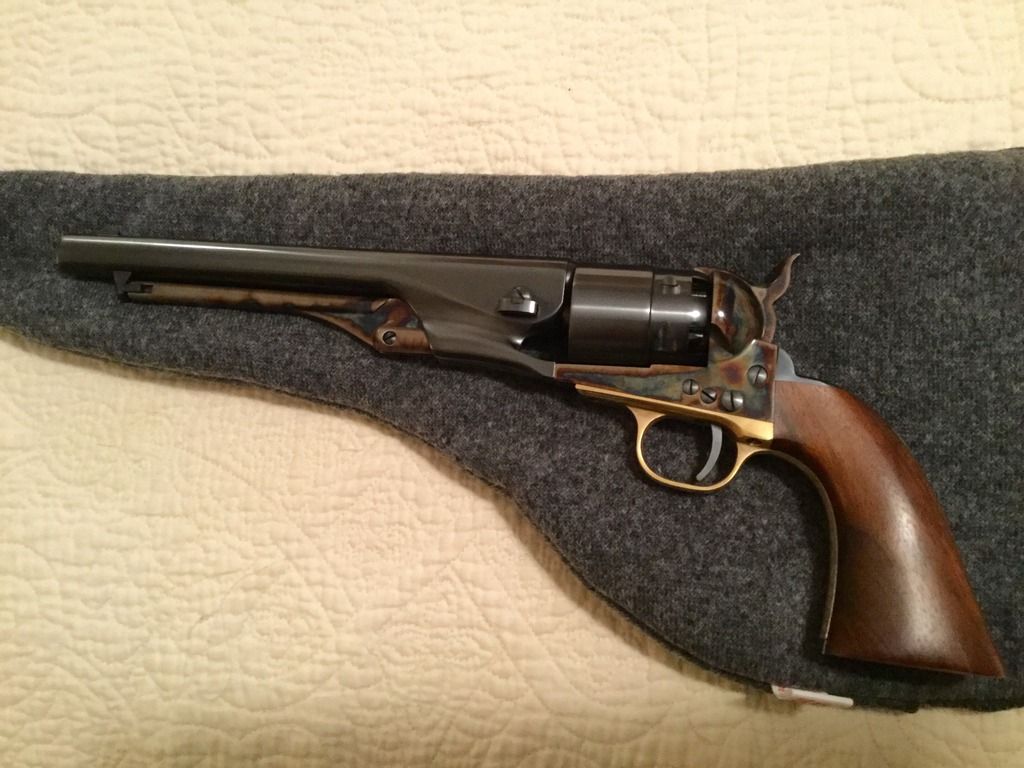Dan C
32 Cal
What kind of finish would a Civil War era C&B revolver have had?
Any help on how to duplicate that finish would be appreciated as well.
Any help on how to duplicate that finish would be appreciated as well.


Pretty consistent color over the entire gun. You may want to vary the finish a bit to show a more natural wear pattern. One way is to apply cold blue then rub it back to create that worn or used look. Or a bit more involved you could rust blue then rub back. For an example here is a photograph I have posted before of an unmolested original 1858 that I own. Notice the uneven wear.What kind of finish would a Civil War era C&B revolver have had?
Any help on how to duplicate that finish would be appreciated as well.



As we know, Hard used guns will get old looking pretty quick, I'd imagine an 1860 Army issued in 1861 , spent the entire war in a holster, in the humidity, in the rain, being maintained once per Sunday by wiping the rust off ....would look pretty beat by 1865.Historically-correct firearm finishes are an art and science that few practice anymore. I can't provide much help there other than to say that modern bluing is quite different from period bluing, and the mottled case hardening you see on original pieces is from actual carburization and heat treatment, not just a decorative finish as is the case with most modern arms today.
Now, if you are talking about how to make a gun look worn, that's another topic. I generally do not like "antiquing" guns. Though I did it to my Pietta 1860 Army after the finish got ruined on it after a massively rainy N-SSA Nationals one year. Of course, what you do with your own stuff is your own business, and it's not like these things are horribly expensive or irreplaceable.
You have to remember that 160 years ago the guns did not look 160 years old. They looked brand new.
But, if you want to do it, vinegar will strip modern bluing in minutes. Then you can add it back with cold bluing and wear it down with steel wool as desired.
Here's mine. As I said, I would never have done this if the finish wasn't ruined anyway.
View attachment 159887
This high condition original looks to have strong remnants of a Charcoal blue?
I think the first technique was a fire blue which wasn't much of a finish but gave a more blue color. This could quickly be worn away to plain metal that either stayed that way or darkened with time- like any old metal tool.What kind of finish would a Civil War era C&B revolver have had?
Any help on how to duplicate that finish would be appreciated as well.
Mike, i believe thars an early gun, i believe the very early guns are like that. I know where no. 27 is, ill have to ask him to look at it. I'll get back to you on thatI gotta say, the " '51 Navy " in Stantheman86's photo he posted is the first I've seen with an upside down wedge necessitating a wedge screw below the wedge. Interesting . . .
Mike
Kibler's Jax black will give the closest color match out of the bottle than any I know of. You could call it a charcoal grey blue. And I believe its accurate to the factory finish of the War of Northern Aggression era. You can leave the Jax black finished untouched for a new look or blend it for a more in service look as I prefer.Well, on the main parts, what was the finish? Charcoal blue? Is there way to obtain that for home use? I have an old Navy 36 and I may want to redo it if possible.
Enter your email address to join: